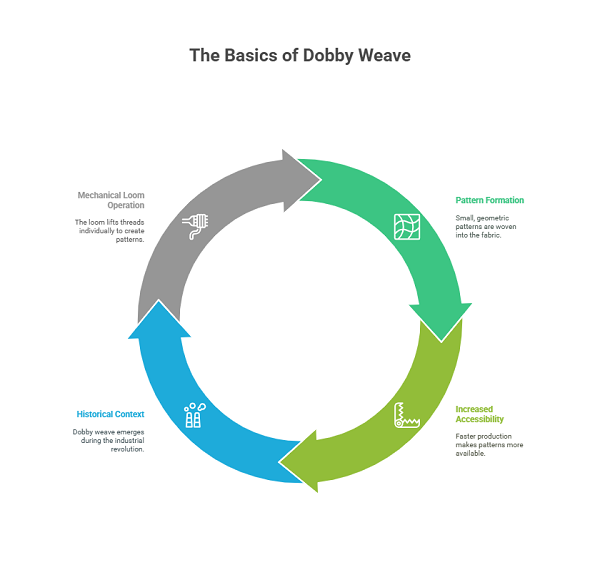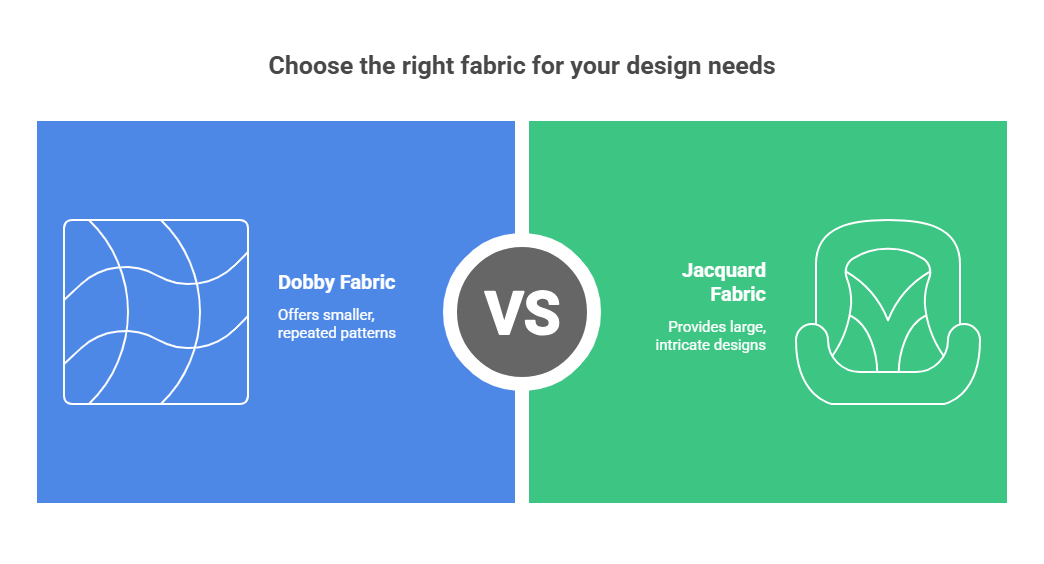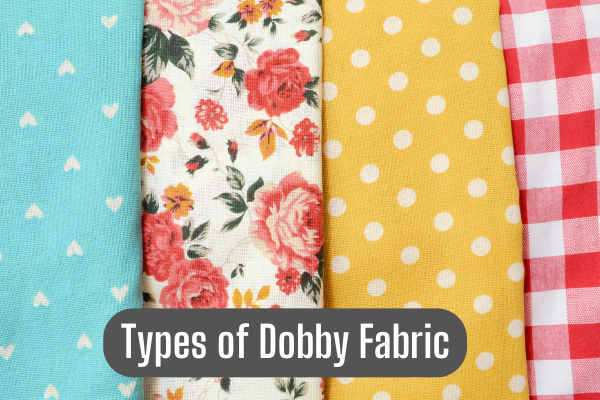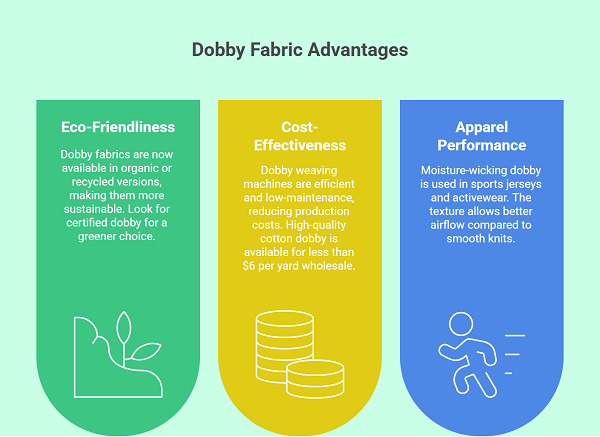What is Dobby Fabric?
Think of dobby fabric like that quiet classmate who always aces every test but never shows off. Understated, detailed, and tough as nails. It’s a woven textile created using a special attachment on a loom—called a dobby loom. This magical little tool controls each warp thread individually, which lets manufacturers produce small geometric patterns throughout the fabric.

Table of Contents
Now, if you’re expecting something loud and flashy, dobby won’t be your first pick. But if you want elegance with subtle personality? This is the fabric you grab without realizing how much you depend on it.
The Basics of Dobby Weave

The Structure That Makes It Unique
The dobby weave is made using a mechanical loom that lifts threads one by one to form miniature patterns. It’s not printed. It’s woven deep into the soul of the cloth. These are not large, bold motifs like jacquard. Instead, they’re tighter, smaller, often geometric—think dots, diamonds, or simple floral outlines.
Fun fact? A standard dobby weave uses 8–32 harnesses. That’s how much complexity hides in what looks like “just fabric.”
History of Dobby Fabric
Introduced in the 1840s (yep, nearly 200 years ago), dobby fabric came to life during the height of the industrial revolution. Before that, similar patterns were hand-woven, often taking days. With the dobby loom, production times dropped dramatically—making these classy patterns accessible to more than just nobility.
Dobby vs. Jacquard – Let’s Settle This

People confuse them all the time. But the difference? Scale and complexity.
- Jacquard fabric uses complex punch cards or digital control to create massive, intricate designs.
- Dobby fabric, on the other hand, uses fewer harnesses and produces smaller, repeated patterns.
In short, Jacquard is opera. Dobby is indie folk—both beautiful, but very different genres.
Types of Dobby Fabric

Cotton Dobby
Popular in shirting. Breathable. Light. And extremely comfortable. You’ve probably worn one without even realizing it.
Silk Dobby
Rare, expensive, and a go-to for high-end women’s wear. Think of evening gowns with a quiet shimmer.
Polyester Dobby
Used mostly in linings, bags, or sportswear. Why? Because it holds up. Water-resistant options? Also available.
Blended Dobby Variants
Poly-cotton blends dominate mass-market apparel. You get comfort and durability. And they’re cheaper. Manufacturers love them.
Common Uses of Dobby Fabric
Fashion Industry Applications
- Men’s shirts account for over 40% of dobby fabric use globally.
- Summer dresses, blouses, even scarves use it—especially the lightweight cotton or rayon dobby versions.
Home Textiles & Interiors
Curtains. Upholstery. Table linens. Dobby fabric adds texture without stealing attention. You’ll find dobby curtains in about 1 in 5 households in urban Europe, according to 2024 interior trends.
Industrial and Functional Textiles
Used in bags, tents, and uniforms. Especially dobby polyester for its resistance to abrasion and moisture.
Key Properties of Dobby Fabric
Durability & Strength
Denser than plain weave. That makes it stronger. A dobby polyester weave can withstand over 25,000 rubs in a Martindale test (the test used to measure abrasion resistance).
Texture & Visual Appeal
It’s all about that weave. You can run your fingers across a dobby shirt and feel its fine bumps. That texture makes it look premium, even if it costs under $10/meter.
Breathability & Maintenance
Cotton dobby scores high in airflow. Some blends may wrinkle a bit. But polyester versions? Practically wrinkle-free.
Why Dobby Fabric is Still Relevant Today

Eco-Friendliness & Sustainability
Many dobby fabrics now come in organic cotton or recycled PET versions. That makes them friendlier to the planet. Look for OEKO-TEX or GOTS-certified dobby if you’re going green.
Cost-Effectiveness in Mass Production
Dobby weaving machines are relatively low-maintenance and efficient. That keeps production costs down. You can get high-quality cotton dobby for less than $6 per yard wholesale.
Performance in Apparel
Moisture-wicking dobby is now a thing. Especially in sports jerseys and activewear. The texture allows better airflow than a smooth knit.
Market Trends & Statistics
Global Demand Overview
The global dobby fabric market stood at $3.1 billion in 2023, with expected CAGR growth of 4.7% through 2030.
Asia-Pacific dominates, producing over 65% of the world’s dobby textiles, thanks to massive output from India, Bangladesh, and China.
Pricing Fluctuations
Cotton dobby prices fluctuated between $4.80–$7.20 per yard in Q1 2025. Recycled polyester dobby remains slightly cheaper.
Future Outlook
Expect smart dobby fabrics soon. Already, some companies are experimenting with dobby woven sensors for wearable tech. Imagine a shirt that can monitor your pulse. Wild, right?
Conclusion
Dobby fabric may not scream for attention, but it deserves your respect. It’s elegant without being flashy. Tough without being rough. It wears many hats—fashion, interiors, industry—and wears them well.
If you’ve ever worn a dress shirt, sat on an airplane seat, or dried your hands with a fancy towel, chances are you’ve touched dobby. And now? You know the story behind it.
FAQs About Dobby Fabric
1. What is the main difference between dobby and plain weave?
Dobby has small woven patterns; plain weave doesn’t. It’s like adding texture to a flat canvas.
2. Can dobby fabric be stretchy?
Not naturally. But it can be blended with spandex or elastane for stretch.
3. Is dobby fabric good for hot weather?
Yes—especially cotton dobby. It breathes well and feels light on the skin.
4. How do I wash dobby fabric?
Machine wash cold. Avoid bleach. For silk or blends, dry cleaning is safer.
5. Why is it called “dobby”?
It comes from the word “draw boy”—an assistant who helped hand-weave patterns before automation. Cute, right?
